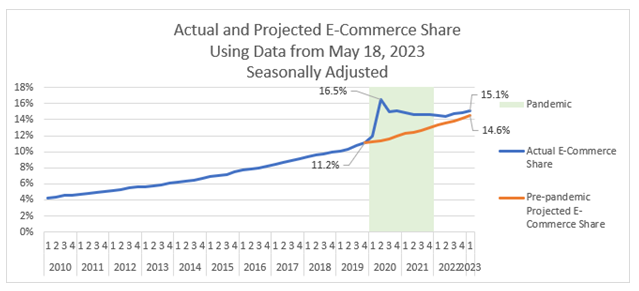Census Says eCommerce Share of Retail Is 15%, Here’s Why It’s Really 22%

About a year ago, PYMNTS detailed how government stats and revisions to those stats can change the way we view eCommerce.
The more online sales get, as measured as a percentage of the overall retail pie, the more firmly entrenched the digital shift is.
Back then, as reported here, the data by the Census Bureau wound up being adjusted upwards by more than a percentage point, indicating that data can be subject to a bit of revisiting and revamping.
And as we showed, the pandemic’s impact on eCommerce continues unabated, even with the return to physical stores.
The chart below shows that Census found that, for the first quarter of 2023, eCommerce sales were 15.1% of retail spend, as measured on a seasonally adjusted basis.
That’s up a bit from the 14.8% seen in the past few quarters.
PYMNTS’ own data takes into account the Census report, which debuted on Thursday (May 18), but also uses the retail findings from the Bureau of Economic Analysis, which shows a more outsized contribution, where the tally is north of 22%, up nearly a full percentage point from the third quarter.

Source: PYMNTS, Census Bureau, BEA
The next chart, as we see below, using trend line projections, shows that the online share of retail sales would have been a bit below 15%, had the pandemic not occurred.
And so, the conventional wisdom here is that, more or less, the trend would have been up to the right, but that the pandemic gave no outsized boost to the results.

But.
As we’ve seen through the lens of recent earnings reports and other data points, the gains are real and long-lasting and firmly entrenched.
In one other data point, also from the Census Bureau, we note that in another report this week, through the April retail sales data, the line item known as “non-store retailers” — which includes (but is not limited to) a sizable slice of eCommerce — was up 8% in April alone from last year, and stands at nearly 15.4% of total retail sales on an adjusted basis.
As earnings season winds to a close, there have been some notable call-outs to the continued gains seen in eCommerce. Walmart is but one of the most recent examples.
As we discussed in our most earnings coverage of the company, eCommerce sales leaped by about 27% in the most recent quarter, as measured on a comp basis. There was notable strength in pickup and delivery, management said Thursday. Sam’s Club saw 19% growth in eCommerce, led by curbside pickup in the U.S. These growth rates continued even with a return into brick-and-mortar settings — indicating that digital has its place even as we return to the aisles, and no matter what the volatility in the official statistics might show.

